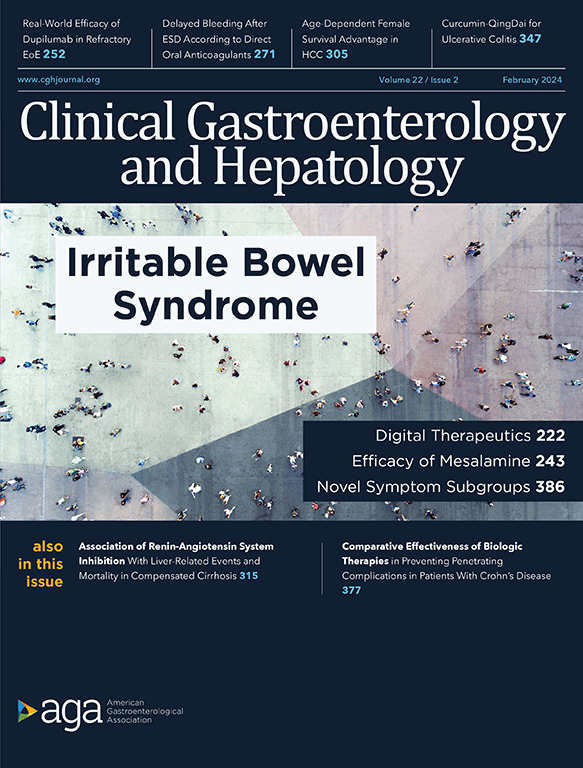After Surgically Induced Remission, Ileal and Colonic Mucosa-Associated Microbiota Predicts Crohn’s Disease Recurrence
IF 11.6
1区 医学
Q1 GASTROENTEROLOGY & HEPATOLOGY
引用次数: 0
Abstract
Background & Aims
Investigating the tissue-associated microbiota after surgically induced remission may help to understand the mechanisms initiating intestinal inflammation in Crohn’s disease.
Methods
Patients with Crohn’s disease undergoing ileocolic resection were prospectively recruited in 6 academic centers. Biopsy samples from the neoterminal ileum, colon, and rectosigmoid were obtained from colonoscopies performed after surgery. Microbial DNA was extracted for 16S rRNA gene sequencing. Microbial diversity and taxonomic differential relative abundance were analyzed. A random forest model was applied to analyze the performance of clinical and microbial features to predict recurrence. A Rutgeerts score ≥i2 was deemed as endoscopic recurrence.
Results
A total of 349 postoperative colonoscopies and 944 biopsy samples from 262 patients with Crohn’s disease were analyzed. Ileal inflammation accounted for most of the explained variance of the ileal and colonic mucosa-associated microbiota. Samples obtained from 97 patients who were in surgically induced remission at first postoperative colonoscopy who went on to develop endoscopic recurrence at second colonoscopy showed lower diversity and microbial deviations when compared with patients who remained in endoscopic remission. Depletion of genus Anaerostipes and increase of several genera from class Gammaproteobacteria at the 3 biopsy sites increase the risk of further recurrence. Gut microbiome was able to predict future recurrence better than clinical features.
Conclusions
Ileal and colonic mucosa-associated microbiome deviations precede development of new-onset ileal inflammation after surgically induced remission and show good predictive performance for future recurrence. These findings suggest that targeted microbial modulation is a plausible modality to prevent postoperative Crohn’s disease recurrence.

手术诱导缓解后,回肠和结肠粘膜相关微生物群可预测克罗恩病的复发。
背景和目的:调查手术缓解后的组织相关微生物群有助于了解克罗恩病肠道炎症的发病机制:调查手术诱导缓解后的组织相关微生物群有助于了解引发克罗恩病肠道炎症的机制:在六个学术中心前瞻性地招募了接受回结肠切除术的克罗恩病患者。从手术后进行的结肠镜检查中获取新回肠、结肠和直肠乙状结肠的活检样本。提取微生物 DNA 进行 16S rRNA 基因测序。对微生物多样性和分类差异相对丰度进行了分析。应用随机森林模型分析了临床和微生物特征预测复发的性能。Rutgeerts 评分≥i2 视为内镜复发:结果:共分析了 262 名克罗恩病患者的 349 次术后结肠镜检查和 944 份活检样本。回肠炎症占回肠和结肠粘膜相关微生物群解释变异的大部分。97 名患者在术后第一次结肠镜检查时通过手术缓解了病情,但在第二次结肠镜检查时又出现了内镜复发,与内镜缓解的患者相比,他们的样本显示出较低的多样性和微生物偏差。在三个活检部位,厌氧菌属的减少和伽马蛋白菌类几个属的增加增加了进一步复发的风险。肠道微生物组比临床特征更能预测未来的复发:结论:回肠和结肠粘膜相关微生物组的偏差先于手术诱导缓解后新发回肠炎症的发展,并对未来复发有很好的预测作用。这些研究结果表明,有针对性的微生物调节是预防克罗恩病术后复发的一种可行方式。
本文章由计算机程序翻译,如有差异,请以英文原文为准。
求助全文
约1分钟内获得全文
求助全文
来源期刊
CiteScore
16.90
自引率
4.80%
发文量
903
审稿时长
22 days
期刊介绍:
Clinical Gastroenterology and Hepatology (CGH) is dedicated to offering readers a comprehensive exploration of themes in clinical gastroenterology and hepatology. Encompassing diagnostic, endoscopic, interventional, and therapeutic advances, the journal covers areas such as cancer, inflammatory diseases, functional gastrointestinal disorders, nutrition, absorption, and secretion.
As a peer-reviewed publication, CGH features original articles and scholarly reviews, ensuring immediate relevance to the practice of gastroenterology and hepatology. Beyond peer-reviewed content, the journal includes invited key reviews and articles on endoscopy/practice-based technology, health-care policy, and practice management. Multimedia elements, including images, video abstracts, and podcasts, enhance the reader's experience. CGH remains actively engaged with its audience through updates and commentary shared via platforms such as Facebook and Twitter.

 求助内容:
求助内容: 应助结果提醒方式:
应助结果提醒方式:


